People
Edwin Charles Carnt, M.Inst.C.E. 1858 - 1915
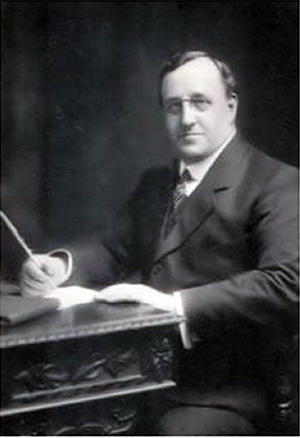
Born on the 24th May 1858, at Ridge Street, Portsmouth, to William George and Elizabeth. Edwin came from a sea fairing family, his grandfather George was a “Measurer” in HM. Dockyards and his father who was born in the Isle of Sheppey went to sea at the age of 16, and served for 37 years retiring as a warrant officer and chief gunner. His father and mother married on the 7th February 1843 and had two daughters and three sons; Edwin was the third child and eldest son. The 1871 the census lists him as being at school in East Greenwich, possibly the Royal Naval College [was previously a hospital until its closure in 1869].
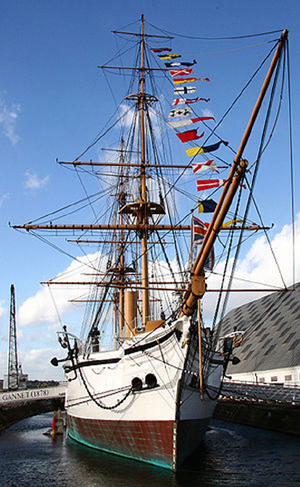
similar to HMS Dragon
His first recorded naval posting is to HMS. President as an Assistant Engineer, this is followed by posting to HMS. Alexander around August 1880, again as an Assistant Engineer. The ship was an Armour Plated Ironclad, and was launched in 1875 at Chatham with a weigh of 9,490 tons and was the flagship of the Mediterranean Fleet. In May 1881 Edwin is shown as serving on HMS. Dragon as an Assistant Engineer, this ship was involved in the Egyptian War and as a result he was awarded the Egyptian Medal.
His marriage to Annie Augusta Christopher took place in July 1880 in Portsmouth, the 1881 census lists him as ‘on vessels’ in the Royal Navy. An announcement in the Hampshire Advertiser in November 1882 states that he is transferred from Barrow-in-Furness where he was an engineer overseer to Portsmouth.
The next record we have is of him is serving as an engineer on HMS. Leander from June 1885 until April 1889. for part of this time the vessel was on the China station In 1889 he was again transferred, this time to HMS. Undaunted now promoted to an engineer. The 1891 census he is shown as living at 156 Beulah House, Dalton, Lancashire with his wife Annie Augusta having been transferred to Barrow-in-Furness as an engineer overseer. In June 1893 he achieved promotion to Chief Engineer and in June 1897 he became a Staff Engineer. He resigned his commission on the 28th February, one assumes to take up his position with J. S, Whites of Cowes, Isle of Wight. The 1901 census shows him living at St Heliers, Granville Road, West Cowes with his wife and Eleanor Carnt a widow. Over the door at Westwood House, Wootton, engraved in stone is the year 1910, therefore one has to assume that Edwin and family had moved into the newly built house.


His death occurred on Thursday 5th August at Westwood House, Wootton, at the age of 57 years. He was the chairman and managing director of J. S. White’s Shipbuilders of Cowes, Isle of Wight.
The funeral on the 9th August was a magnificent affair, starting from his home at Westwood House, Wootton the chief mourners were, Eng.-Captain A.J. Carnt R.N., Mr. S. G. Carnt [nephew,] Eng. Comdr. David Bennett R.N. and Dr. Denton. There were leading official of J. S. White’s and about 1000 employees, there were representatives from the Admiralty and naval offices in uniform. Many representatives from companies with whom he had dealt were also present. His widow did not accompany the coffin, and at her special request the obsequies were of the simple and quiet character. The solemnity and impressiveness, emphasising the sense of the great loss felt by the passing away of an exception man who could be ill spared. The cortège was met near at the junction of Brocks Copse Road and Whippingham by guests, staff and the workforce of J. S. Whites who lined both sides of the road, those assembled then followed the cortège to St Mildred Church, Whippingham.
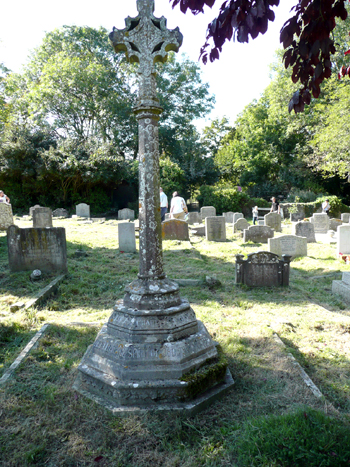
St Mildred's Church Whippingham
The coffin draped in the Union Jack and covered with exquisite lilies from his widow was met at the lichgates by The Rector [Canon Clement Smith, M.V.O., R.D. chaplain-in-ordinary to the King and Rev. Charles Collis, Vicar of Freemantle [Southampton], who was previously at St Paul, Newport. The church was overflowing with floral tributes from family, J. S. White’s management, workforce, companies and friends.
Mrs. Annie Augusta Carnt had no children and gave Westwood to her niece Katherine Margaret Mitchell around 1924, however she is still listed as living there in the 1927 edition of Kelly’s Hampshire and the Isle of Wight. She died in April 1927, and her death is registered in St. Georges Square London. She is interred next to her husband in the family grave at St Mildred’s Church Whippingham. Newspaper reports of the time say that people who knew her spoke highly of her, and how she retained an interest in the well being of the less fortunate at J. S. White’s. Also buried in the family grave at Whippingham is Edwin younger brother, Walter George Carnt of Manchester who died 4th February 1916 aged 55 and his wife Eleanor Anne.
20th June 1920 Dedication Service
At St Edmunds Parish Church, Wootton on Sunday morning 20th June the Bishop of Southampton dedicated the splendid gifts by Mrs Carnt in memory of her late husband. These were the complete installation of electric lights within the church, this together with its own generating equipment. The re-plastering of the walls, and restoration of the fabric was carried under the supervision of an architect, the work also included an overall of the organ. The church was fully lighted for the service and the Bishop said it made the service more cheerful, and there were not many churches that had such benefits.
The impact Of Edwin C. Carnt On J.S. White’s
He was distinguished by his commanding presence and a broad energetic, constructive and powerful mind. His keen grasp of detail, foresight, quick and sound judgement was remarkable, even among those whose business calls for thepossession of these qualifications. He was an untiring worker, and to his personal energy and incentive is to be ascribed the re-entry into the front rank of the old business of “White of Cowes”, which concern he joined as engineering director in March 1898. Immediately following his appointment the engine works that had been established in 1889 on the site of the old Medina Dock and the shipyard was subjected to an exceptionally vigorous, comprehensive and enlightened policy. At that period the construction of machinery had been confined to the manufacture of high-speed fast- engines running, pinnace engines, and various types of small machinery for mining vessels, yachts, and small mercantile craft. The first part of his development programme took the form of the erection of a new boiler shop immediately joining the engine works, to replace the existing one attached to the iron shipbuilders department at East Cowes. The White-Forster boiler was in its initial stages, and orders were received for a considerable number of this new type for re-boilering of various torpedo craft at home and abroad. Immediately following this, the Admiralty placed their first order with the company for the complete machinery for 1st class torpedo boats, which hitherto had been sub-contracted by White’s. The order consisted of four vessels Nos. 114, 115, 116 and 117, with single screw reciprocating engines, triple expansion type 3000-i.h.p. and coal fuel boilers. This order embodied a high water mark in interchange ability of equipment, and involved the re-construction of the engine shops, the re-equipping of the firm tool room, and the introduction of a “Limit Gauge system. This contract was successfully executed, and allowed the Admiralty to gain confidence in the company’s ability. This was proved when an order for a further two vessels of the River class, these embodied twin screw reciprocating engine of the four cylinder triple expansion type totalling 7000 H.P. with coal burning boilers. Interchange ability was an important part of the order allowing the exchange of engines between ships; they were built and preformed well in sea trials.
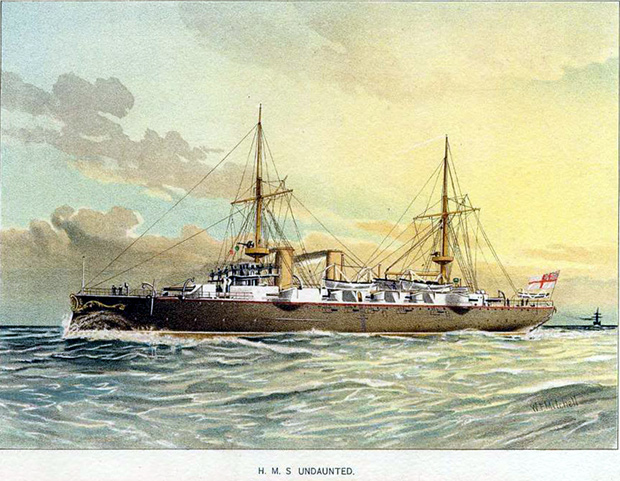
The following year [1905] the Admiralty introduced turbine machinery an oil burning boilers for coastal destroyers, these were the forerunners of the Tribal class, the specification called 33 knots at full power for 8 hours. The ships were fitted with Parsons Turbines [first manufactured by that company] and meet the required specification. In order to build these ships a considerable amount of re-construction and re-equipping of both the engine and shipyard as required. Land was reclaimed on both sides of the Medina allowing the extension of the foundry, machine and boiler shops. The modernisation of the works helped secure repeat orders for three batches of coastal destroyers and three Tribal class ships. Whilst torpedo craft machinery and other developments evolved Edwin Carnt ensured that the company kept abreast with them all, and to him must go the credit for the company’s success.
The engine department now had an annual output of a 100,000-H.P. and in order ensure that the fitting out of ship was not delayed he sunk re-enforced concrete piles on the site of the Medina dock and erected a 80-ton electric crane of the hammer head type which is still a landmark in the Solent.
In 1911 a serious fire, which started in the pattern shop, destroyed part of the engine works including pattern shop, patterns, tool-room, machine and erecting shops. Again the management skills of Edwin Carnt came to the fore, and he almost built a complete new factory, incorporating all the latest technology. The rebuilding work did not stop the company’s development work, so ensuring that J.S White remained at the forefront of design. With the advent of aviation he realised it’s important and in 1914 he had designed a layout for the finest aviation works in existence at the time {Somerton]. He was a very approachable man and carried working even when his health was at risk.
It was in 1912 that the Hammer Head Crane that still is an icon of the Cowes skyline was built, one has to assume the Edwin Carnt was very much involved.
He joined the board as manager of the engineering department in 1898 and was appointed managing director in 1911. The number employed in 1898 was 350 in engineering and 250 in the shipbuilding yard, a total of 600. In 1915, there were 1600 in engineering and 1500 in the shyipyards, totalling 3100. The output of engines in 1898 was 3000 horse power [HP], and in 1915 it was upwards of 100,000 HP.
Footnote: Mr. Sydney G. Carnt

He was the nephew of Edwin Carnt, and was also the London director for J.S. Whites. A practicing solicitor he had been the Deputy Town Clerk and Deputy Clerk of the Peace for the Borough of Salford, Lancashire. He was a partner in the legal firm of Clark, Son and Carnt of 35, Bucklersbury, London E.C.
Source: Isle of Wight County Press
This page was last edited on: 26th January, 2022 17:50:23




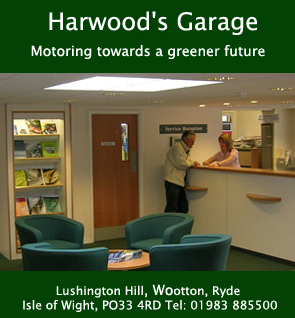




 Help To Support Us
Help To Support Us





 Our Facebook page
Our Facebook page Get the latest Tweets
Get the latest Tweets You Tube
You Tube RSS Feed
RSS Feed
